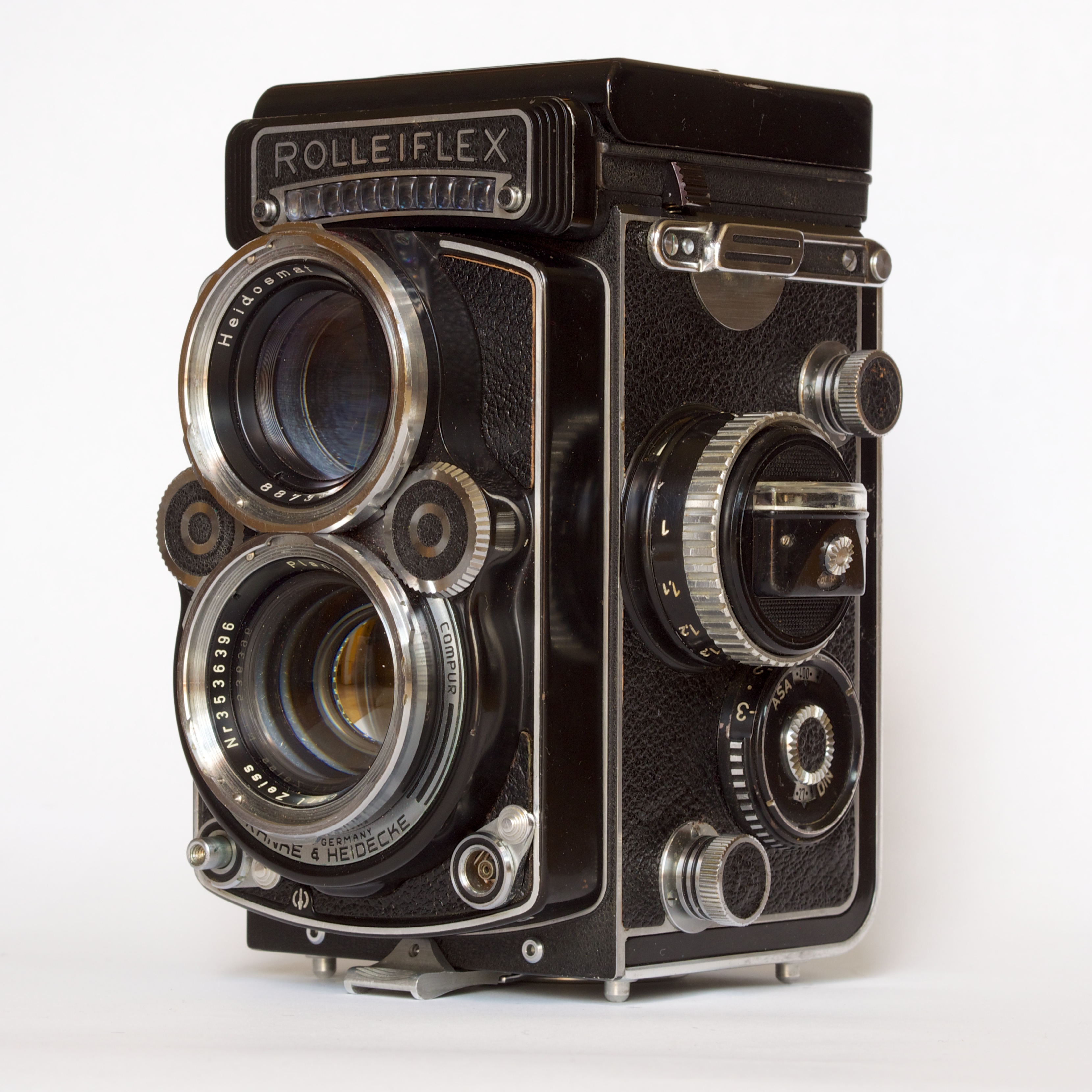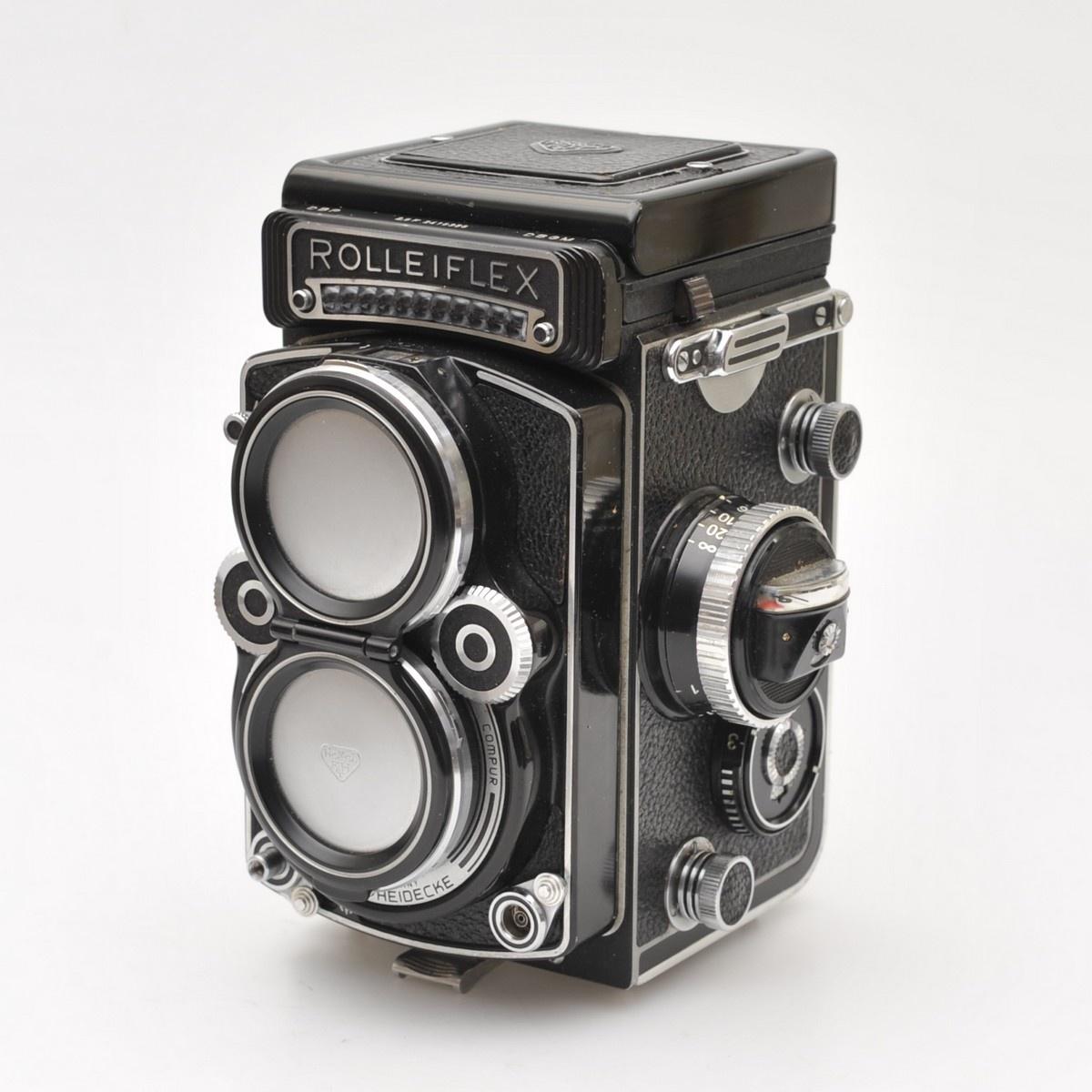
 Photographica Pages
Photographica PagesAn online guide to collectable cameras and relatedstuff

Tele-Rollei (Tele Rolleiflex) The Tele Rolleiflex, known to most collectors as the Tele-Rollei, was introduced in 1961. The Tele-Rollei, and it’s companion, the Rolleiwide were marketed in response to those wishing for Rolleiflex cameras with interchangeable lenses. Rollei had been pursuing a design with an interchangeable lens board, but the cost was so high that it was simpler to offer cameras with fixed wide and telephoto lenses. The Tele-Rollei is based on the same body as the Rolleiflex E series. It is fitted with a 135/4 Zeiss Sonnar taking lens, and a 1355/4 Heidosmat viewing lens. The viewing hood is removable, and is unique. The sportsfinder in the hood has a field of view matching that of the 135 Sonnar.
The Tele-Rollei uses Bayonet III size accessories, but requires a different set of Rolleinars unique to this model. There is a Rolleinar 0.35x which allows focusing from 4' 5' (1.33m) to 9' (2.74m), and swings out of the way allowing you to leave it on the camera when focusing beyond 9'. This Rolleinar is particularly useful for portraiture work as the camera does not quite focus close enough without it for a head shot. There is also a Rolleinar 0.7x which allows focus from 3' (0.91m) to 4' 6.5'. As there would be a gap in focus distance with the Rolleinar mounted and removed, it was not built in the swinging style like the 0.35x.
There are two distinct types of Tele-Rollei, the type 1 and type 2. The type 2 does not replace the type 1, but was sold concurrently with the type 1 after 1970. The type 2 accepts 220 film, while the type 1 does not. The finder is also supposed to be different between the two models, the type 2 having an open area around the frame allowing you to see what is happening outside the image area. I suspect that type 1 cameras built after 1970 have the later style finder. The camera pictured is a type 1 with a late serial number, and it has the later style finder. Finders do get switched over the years (they are removable), so it's possible that the finder on this camera was replaced with one off of a type 2.
Serial numbers run from 2,300,000 through 2,304,999 for the type 1, and 2,305,000 through 2,308,377 for the type 2. This would indicate a production run of 8377 units. The serial number list from Rollei doesn't always seem to be as accurate as it seems. We've had many cameras that were outside the serial number range indicated. The example shown is serial number 2305265, which would indicate it was a type 2. I would not be surprised if type 1 cameras were assembled in small batches using type 2 serial numbers after 1970. Production was ended in 1975. Cost in 1961 was $399.50, compared with $336 or $349 for the Rolleiflex 2.8F with Xenotar or Planar respectively. By 1975 the cost had risen to $940 for the type 1 and $988 for the type 2. I suspect not too many type 1 cameras were sold after the introduction of the type 2 as the difference in price was relatively slight.
The Tele-Rollei Type 1 with exposure meter added.
The later style viewing hood, with the sportsfinder open.
The special Rolleinars for the Tele-Rollei, the 0.35x (left) and the 0.7x (right).
The 0.7x Rolleinar mounted on the camera.
The 0.35x Rolleinar mounted on the camera.
Another picture of the 0.35x, swung out of the way, allowing focus from 4' to infinity without removing the Rolleinar from the camera.
The 03.5x Rolleinar with it's soft plastic case.
The Tele-Rollei Type 1 with exposure meter added.
The later style viewing hood, with the sportsfinder open.
The special Rolleinars for the Tele-Rollei, the 0.35x (left) and the 0.7x (right).
The 0.7x Rolleinar mounted on the camera.
The 0.35x Rolleinar mounted on the camera.
Another picture of the 0.35x, swung out of the way, allowing focus from 4' to infinity without removing the Rolleinar from the camera.
The 03.5x Rolleinar with it's soft plastic case.
- SXRMark wrote: This is the rear of my Singapore Rollei Planar. Front is identical to yours (serial number 104xxxx). The bayonet is a simple plate with three lugs and held on with three screws. Very easy to remove and I guess replace with an alternative mount. Note the auto aperture pin is missing on mine (and two of the screws are non-original.
- Planar DirectLight X. Complete LED video wall solution with advanced video wall processing, off-board electronics, front serviceable cabinets and outstanding image quality available in 0.7, 0.9, 1.2, 1.5 and 1.8mm pixel pitches.
Kumpulan Serial Number Idm
Serial numbers run from 2,300,000 through 2,304,999 for the type 1, and 2,305,000 through 2,308,377 for the type 2. This would indicate a production run of 8377 units. The serial number list from Rollei doesn’t always seem to be as accurate as it seems. We’ve had many cameras that were outside the serial number range indicated. The example shown is serial number 2305265, which would indicate it was a type 2. I would not be surprised if type 1 cameras were assembled in small batches using type 2 serial numbers after 1970. Production was ended in 1975. Cost in 1961 was $399.50, compared with $336 or $349 for the Rolleiflex 2.8F with Xenotar or Planar respectively.
